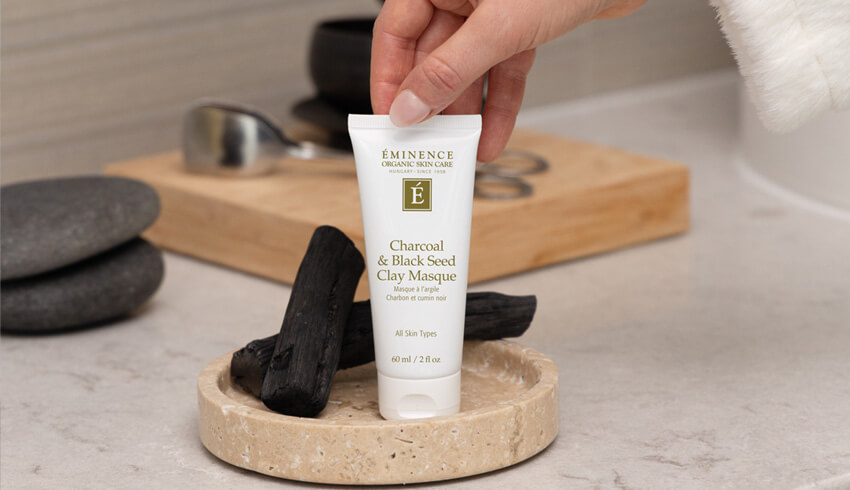
Acne is not a one-size-fits-all condition. Depending on its cause, acne may manifest as occasional pimples or as a more chronic, lifelong issue. In fact, up to 80% of people will experience acne at some point in their lives. One of the best ways to combat acne is to address its root cause. Here are five common causes of acne, along with our tips for banishing breakouts for good.
What Causes Acne?
As International Trainer Brian Goodwin explains, acne is an inflammatory skin disease that’s caused by things like excess production of sebum, dead skin cells or harmful microbes colonizing the skin. To complicate the matter, you may be dealing with a combination of these issues. Let’s review these factors and discuss how they play a role in the emergence of breakouts, blemishes and more chronic acne:
1. Clogged Pores
Every pimple begins the same way: with a clogged pore. Each of our pores is made up of a hair follicle containing a sebaceous (oil) gland which performs a key function for skin health. Sebaceous glands release sebum, a waxy, oily secretion that helps to lubricate and soften the skin’s surface. While this is necessary for keeping the skin properly balanced, there can be issues with this process. When sebum travels along the follicle towards the skin’s surface, it can get trapped by dead skin cells blocking its path. Acne occurs when oil and debris combine with trapped bacteria, causing the infection and inflammation that we call a breakout.
2. Excess Oil Production
Is your skin extra oily? Oily skin is thought to be caused by a genetic predisposition to overproduce the hormone dihydrotestosterone (DHT) which causes the skin’s sebaceous glands to produce more sebum. Sebum, while often seen as an annoyance for oily skin types, plays a crucial role in maintaining the skin’s moisture barrier and protecting it from harmful environmental factors and microbes. However, when the skin produces too much oil, its pores enlarge and stretch in an attempt to contain the surplus. If excess oil becomes trapped, it can combine with the dead skin and bacteria that have settled inside the pore, causing breakouts. The severity of your acne breakouts can depend on your body’s propensity for excess oil production.
3. Bacteria
Everyone has acne bacteria living on their skin, but not all acne bacteria trigger pimples. According to Medical News Today: “Research suggests that the severity and frequency of acne depend on the strain of bacteria.” The strain of bacteria that contributes to acne is called Propionibacterium acnes, or P. acnes. This bacteria is generally harmless, but under certain conditions (such as in a clogged pore, surrounded by oil and no air) can trigger an immune response that causes inflammation of the surrounding tissues.
4. Hormones
Hormones influence acne at all ages, with hormonal fluctuations often increasing sebum production and leading to breakouts. Changes in the body’s androgen levels, which are common during puberty, menstrual cycles or pregnancy, can trigger acne. Typically, hormonal acne appears on the lower half of the face, such as along the chin and jawline. It’s no secret that many teens struggle with acne. Teen acne, a form of hormonal acne, is caused by changing hormones affecting sebum production. The key difference is that teen acne is closely associated with puberty and often clears up at the onset of adulthood, explains Brian. Acne that persists beyond the age of 25 is referred to as persistent acne. Teen acne can appear on the face, neck, chest and back, while adult acne is more often localized to the face.
As Brian explains, hormonal fluctuations can alter the balance of sebum's components, such as fatty acids and triglycerides. Additionally, hormones influence cellular turnover rates and the skin’s inflammatory response, leading to congested pores and potential infections.
5. Genetics
Unfortunately, your own unavoidable genetic makeup often comes into play when it comes to breakouts. Some people are genetically more prone to their sebaceous glands getting inflamed by hormones, oil and bacteria. The odds are that if one of your parents had moderate to severe acne, you are likely to experience symptoms as well.
Product Picks
What Are The Types Of Acne?

Acne comes in various forms, each with distinct features that require different approaches to treatment. Blackheads are a type of comedone where the pore remains open, allowing sebum to oxidize and turn black, giving the characteristic dark appearance. Blackheads are often found on areas of the face like the nose and chin and can be stubborn due to their open exposure to air. Whiteheads, on the other hand, form when sebum and dead skin cells are trapped beneath a thin layer of skin, creating a small, white bump. Whiteheads are enclosed, making them less exposed to air, which prevents oxidation.
Papules are small, inflamed bumps that appear red or pink and are often tender to the touch. These occur when pores become clogged and inflamed, but unlike pustules, they don't contain pus. Papules can make your skin feel rough and bumpy.
Pustules are similar to papules but contain pus, which gives them a white or yellow center. They often appear surrounded by redness, indicating infection or inflammation. They are what most people recognize as typical "pimples."
Nodules are a more severe type of acne that forms deeper under the skin. They are large, hard and can be very painful. Nodules tend to develop when the buildup of sebum and bacteria causes inflammation deep within the pore. Unlike pustules, nodules do not have a visible "head" and can take longer to heal. They often require more intensive treatment due to their deep nature and risk of scarring.
Acne Treatment Options
One of the best ways to tackle the causes of acne is through your skin care routine. To keep your skin clear and blemish-free, we recommend using our Acne Advanced 3-Step Treatment System. The products in this innovative collection are designed to treat acne and prevent future breakouts, with results in as little as 28 days.
For best results, contact your favorite Eminence Organics Spa Partner for a consultation or an acne facial to get a routine tailored to your skin’s unique needs.
Do you suffer from acne? How has it affected you, and what has helped you find relief? We’d love to hear your story. Share it with us in the comments and join the conversation on social media.




